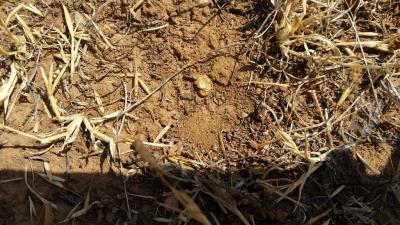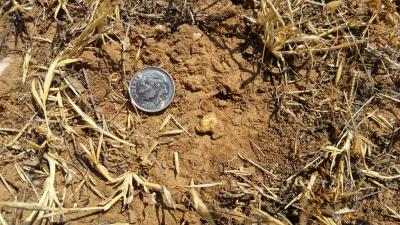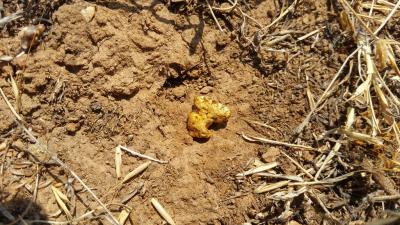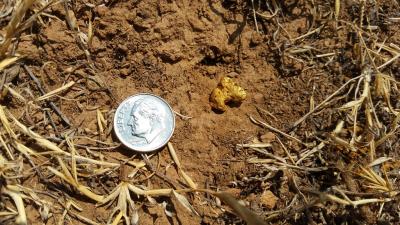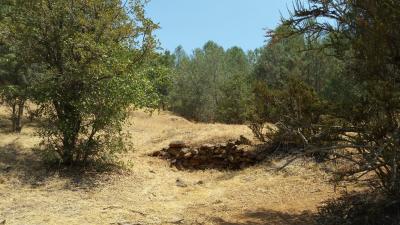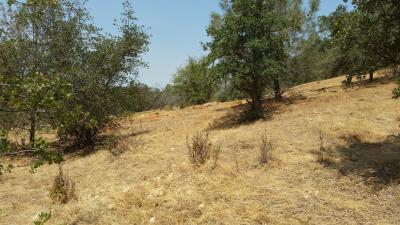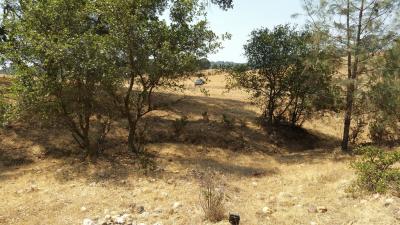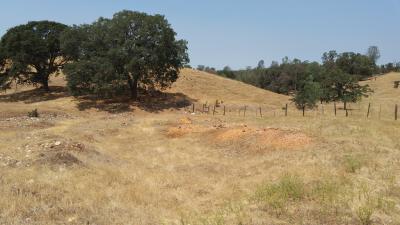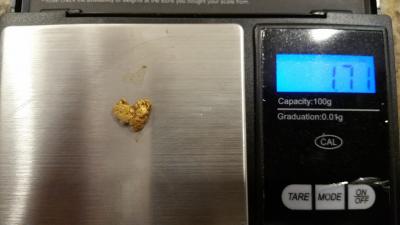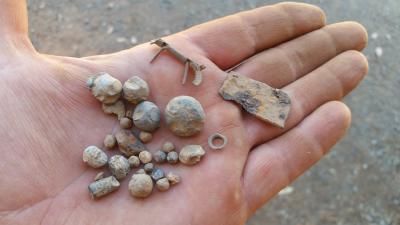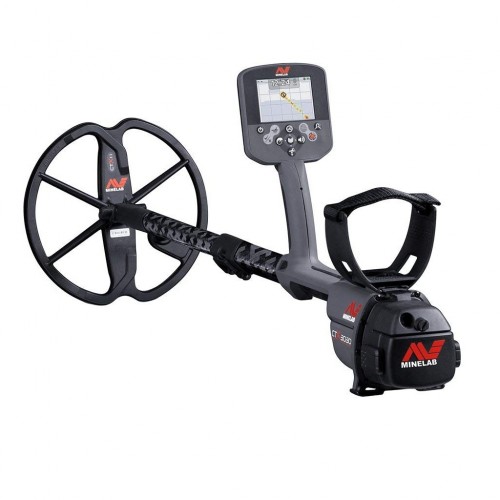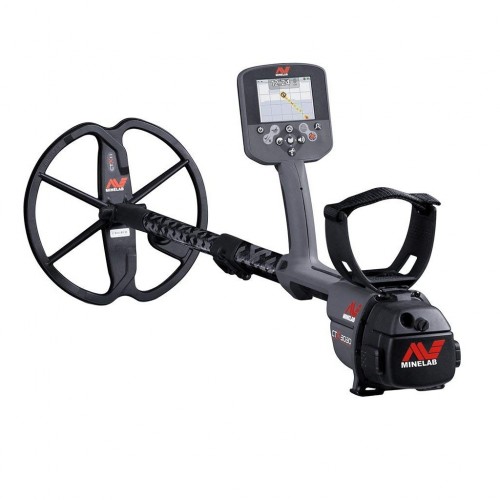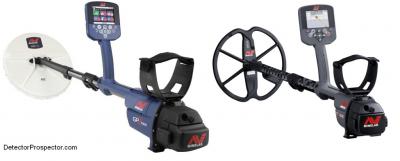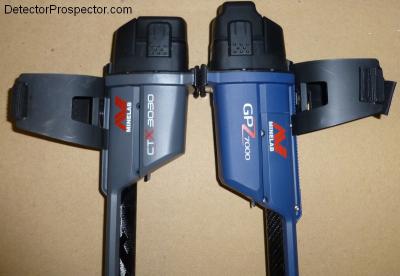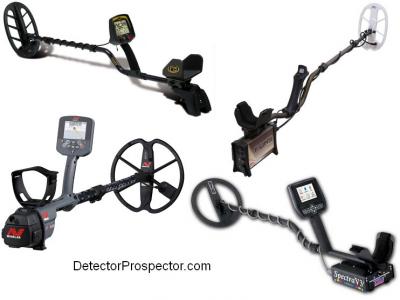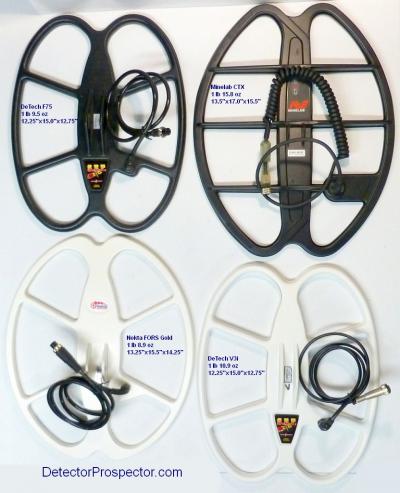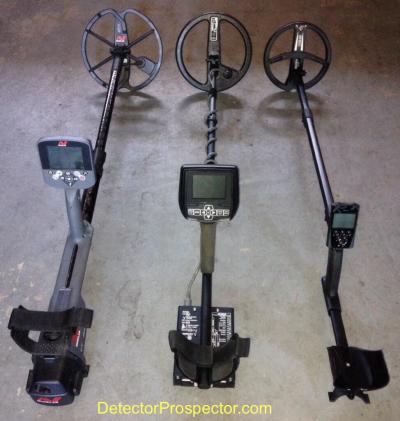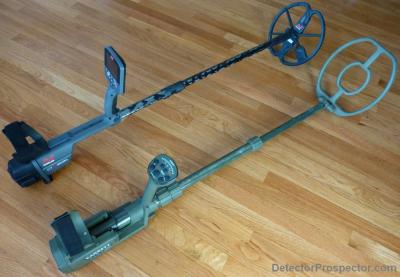Search the Community
Showing results for tags 'minelab ctx 3030'.
-
It's been over a month since I have had a chance to get out and hunt for gold. Last time out I got my butt whipped by my wife and so I been licking my wounds and sulking since then. She took off for her sisters this weekend so today I decided to go to the foot hills. My goal was a short half day hunt. My buddy has some property that has produced some small nuggets for me in the past. Nothing bigger then 1/2 gram and most are only a few grains but it's fun and something to do. The only problem with the place is it's riddled with bird shot and lots of other goodies...so you are digging constantly. I took my time getting up this morning and got to the ranch about 9am with my arsenal. I intended to start with the 7000 in normal ground mode over an area that I got 6 little nuggets last time I was there. I had pretty much worked the area over with the sdc 2300 so I wanted to see if there was anything deeper. I get started and it's hot already and before long sweat is dripping off my face like a waterfall while I'm digging bird shot, old musket balls and bullets. An hour and a half later no gold and it's time to go to the truck and have a beer...and a water. Now that I'm revitalized I decide I want to explore another area so I grab the 2300 and go on a walk about. The ranch is 100 acres but there is an adjoining property that I can go to as well so I head that way. Another hour and a half go by and nothing to show but more round balls and bird shot. On my way back to the truck (for another beer) I see a place that I have always wanted to try with my ctx 3030. It looks like an old dam in a creek that the old timers put together. I figure if I cant find a nugget maybe I can find a old coin. So I go back to the truck and grab the ctx. This is my last try as I wanted to get back home and finish some projects that I have going on there. There are lots of tailing piles on this pace so I start working them with the ctx as I'm heading to the dam. I was going kinda fast with the ctx and I dig a few more pieces of lead. As I start heading up the hill to the creek I'm swinging along carelessly and I get a nice low tone. I look at my display and it says 12.10 and there is a nice little red dot on the screen. I immediately think gold or a piece of lead or 22 casing. As I'm looking down my eyes focus on something yellow. Now I'm thinking probably a piece of yellow dirt. so I put on my glasses and low and behold it looks like gold! I've only been detecting for about a year now and I've never found a sun baker. I scrape a little dirt away and sure enough it's a nugget. I don't know how deep it goes into the ground so I wanted to savor the moment and go back to the truck for my camera. It's not nearly as big as what some of you fellas get but it's the biggest nugget that I have found so far in my year of detecting. 1.71 dtw And I kept telling my self. You gotta be kidding me. I found it with my coin machine? So what did I do next? I go back to the truck put the 3030 away and go back to the spot and work it over with the 2300 for a good 30 minutes. Nothing but more bird shot strick
-
Does anyone have a copy of the gonehunting (GH) program for the Minelab CTX 3030 that they are willing to share? -Bernie
-
I have been using my 3030 for almost 2 years now and I still only use Smooth for the sound. It is quite good but sometimes it 'balances out' or becomes difficult to get it to repeat consistently. Recently I have been reading about some CTX programs for download and others use Pitch Hold. I tried it last night and it was just so odd. The threshold goes to a different sound and pitch, the volume goes to a lower level and I have a hard time hearing the target. After this I tried Normal and it makes me wonder how someone can use this also. Long is close to smooth. The difference is so much and unusable to me that I think I must send it in for repair. Before I do that I will have a friend come over and compare my sounds to his. Does anyone else have problems with these sound settings? Mitchel (All of this makes me want to get my hearing checked!)
-
934 downloads
Gold Hound/ Dale Gold Nugget modes for the CTX These modes contain discrimination patterns and audio settings that opimise the CTX for nugget hunting. How to share mlf files http://www.nhmetaldetectingforum.com/index.php?topic=10671.0 Minelab CTX 3030 Data & Reviews Minelab Metal Detector Forum -
155 downloads
Gary UK programs for CTX 3030 from http://www.metal-detecting101.co.uk/2015/01/minelab-ctx-3030-programs-all-free.html Ten of Gary's most used settings How to share mlf files http://www.nhmetaldetectingforum.com/index.php?topic=10671.0 Minelab CTX 3030 Data & Reviews Minelab Metal Detector Forum -
CTX 3030 on gold nuggets Hi guys I have had the CTX since it was released. However I did not purchase it for the same reasons as most others bought it for, I bought it primarily to look for larger gold in areas that have a high trash density where non discriminating detectors like the GPX will drive you nuts digging junk. It has the best discrimination and target separation of any detector I have used this far, particularly if the trash is iron. That is why I use it for this job if the trash density is low I just swap back to a gold detector and would never waist my time using it in low trash areas for gold nuggets. To give you an idea of what I am talking about with trash density’s and to establish an understanding I will break them into 4 groups. 1- Very low trash= up to 10 targets in a 5mx5m area. This area I would use a gold detector like the GPX in. 2- Low trash 10 to 25 targets in a 5mx5m area. This area I would still use the gold detector in if it is worthwhile. But if the gold density is low I will start to use the discriminating detector. 3- Med trash= 25 to 50 targets in a 5mx5m area. I am definitely reaching for the discriminating detector now unless there is a high gold density. 4- High trash 50+ targets in a 5mx5m area. Discriminating detector only! any other is a waist of time. Ok now that I have established a base line of trash density’s we can get to the nitty gritty, I will go through the settings that have an effect on gold field performance one by one and explain how I use them, or play them against each other to squeeze the best performance out of the CTX that I can for my given situation. Target trace; I turned it on and would never turn it off as it is very useful in helping to identify a target or multiple targets under the coil and I am yet to find a reason to turn it back off. Why this key feature was not on by default is anyone’s guess. Target trace pinpoint; I turned this on and never turned it off ether, as it greatly assists in pinpointing particularly if there are multiple targets under the coil, by using this feature you can pinpoint only the desired target most times. Threshold Pitch; I run it at 13 but everybody is different all you are after is a threshold pitch that is comfortable for you to listen to all day. Threshold level; set up threshold so that it is soft but clearly audible, the manual covers this in detail. Volume Gain; now this is a important one, I mostly just have it at max=30 but if you are getting spurious noises like those faint blipping noises that you can sometimes get in mineralized ground you can wind this back to cancel them out with less loss of depth than turning back the sensitivity, however it has its limitations in this regard. It is basically an audio amplifier that amplifies the target signal. Sensitivity; Obviously you want to keep this as high as possible, but in the gold fields the ground usually contains various minerals and because the CTX is a multiple frequency detector ‘Auto’ sensitivity is more effective in these conditions, because the processor individually adjusts each of them to their optimum setting. Where as in manual you can only adjust them all to the same setting which means that if one is effected by mineralization or emi and becomes noisy, you have to turn them all down to the level where the noise stops in that frequency and you are effectively choking the rest to quieten the detector. So this is why Auto is the best option on the CTX in gold field areas. I can usually run Auto +3 but I turn it down if I am getting a lot of spurious ground noise and I can’t use any of my other tricks to get rid of the noise. Response; My favored response is ‘Long’ but I also like ‘Normal’ as well. It depends on my anticipated target size and trash density as to which one I’ll use. In a medium to high trash area I prefer Long particularly if the gold size is 3g+ like in tailings oversize piles. I like normal for smaller gold and lower trash density. Recovery Fast; I nearly always have this on as it aids in target separation. And superior target separation is one of my main reasons for using the CTX Recovery Deep; I have this on if the trash density is low or medium particularly when using the smaller coils. Recovery deep improves the ID on deep targets and can improve the signal on deep targets marginally but it can cause spurious noise in some mineralized ground. So if it’s on and you are getting spurious noise recovery deep could be the cause so try turning it off before dropping the volume gain or sensitivity. Target Separation; The 2 best target separation modes for gold nuggets are ‘High Trash’ and ‘Ground Coin’, I use High Trash the most as most areas I target most with the CTX are med to high trash areas and High Trash is good at handling mineralization and still gives you very good target separation. In a area with low trash density that is mineralized I use Ground Coin but it dose not perform well in high a trash density as you will get some blending of targets. In a low to very low mineralization area ‘Ferrous Coin’ performs very good no matter the trash density, but is no good in mineralized areas as you will get blending of the ground and target, which makes the target ID go crazy and blending is a problem. Gold Hunting Discrimination and Audio Patterns. Below I have posted a few example modes that have a good base discrimination pattern and audio pattern to suit the situation that I use them in. 100’s of hours of work went into building each of them. When building your own pattern I recommend that you do what I did which is scan as many nuggets as you can get your hands on of various sizes. When I did this I scanned just over 1000 nuggets ranging from .2g to 32oz and I put the ones that show on the edge of my pattern aside and took them to a few locations and buried them in different mineralization to test and modify my mode’s, then I got my bucket of junk and scanned 1000’s of pieces of junk commonly found in the gold fields. Then I modified my modes again to cancel out most of the junk whilst still keeping most of the nugget area open. They are not perfect by any means but they have been pretty useful for me as a base but if I keep getting one type of junk in a specific area I will modify the discrimination to deal with it and save it as a new mode in my file. You might also notice that in all of my gold specific discrimination patterns that I have the top two lines rejected, this is because in mineralized ground the ground will give you a blipping signal always in these top two lines and rather than sacrificing performance by turning the sensitivity or audio settings down I dealt with this by blanking it out, buy doing it how I did I lost no depth due to having to back off the settings and no good target ever ID’s only in these lines. The audio patterns that are part of the mode also have a few tweaks that I have done for gold nugget specific reasons. If you look at the Audio profile in the exchange software you will notice that I have set the low Ferrous tone line very low down at the 32 ferrous line, I did this because I found that when using the discrimination pattern if the tone was set higher up at say 17 for example I would get some audio blanking or mixing on some good targets in very trashy areas. This is the main reason that most of my Gold nugget modes have ether a ‘2 Ferrous Tone’ or ‘Combined’ ‘Tone ID Profile’. But when set low at 32 ferrous line the separation was very good in a cluttered area. It is not that noticeable on larger 3g+ nuggets but on the smaller ones even on the smaller coils (6in and coiltek elliptical) if I had the ferrous audio line higher it would not separate the nugget from the trash as efficiently. That is why I mostly prefer the discrimination pattern over the open screen also. http://www.detectorprospector.com/forum/files/file/4-gold-hound-ctx-gold-modes/ Coils My preferred coil for the CTX is the standard 11in coil because I mostly chase the bigger gold in the tailings oversize piles and old diggers camps. But in areas with predominantly smaller gold I put on the coiltek 11x5. I also did away with the skid plate on the ML 11in coil as it wears out in a matter of hours in gold field situations and I silicon-ed a piece of 3mm lexan plastic in its place. And after 2 years of heavy use it is still in good condition!
-
Hi Y'all. I've been all over the map as far which detector I think I'm going to buy. Right now I think it's either going to be the CTX3030 or White's V3i. I got some questions. How does the Minelab's auto ground balance technology compare to White's auto ground balance technology? In particular, in terms of ground balancing, how does the CTX 3030 compare to White's V3i? How do the discrimination abilities of the CTX3030 and V3i compare? White's user manuals are written much better than Minelab's user manuals. How much do you agree with this statement? Minelab claims, "FBS (Full Band Spectrum) simultaneously transmits, receives and analyses a full band of multiple frequencies." Whiteselectronics claims, "... digital waveforms also produce unde- sired harmonic frequencies. Lots and lots of harmonic frequencies, 10’s or even 100’s of them. These harmonics have no useful energy and are not part of the signal processing. So while we can claim to transmit many, many frequencies, we cannot claim to process or use them. Therefore, we could easily claim the Spectra V3i transmits 17 frequencies, or 28, or 39, or 55—we could get plain silly with this. And such a claim would be true, technically speaking, but since all those extra frequencies are not actually used, it would be misleading to make such a claim. White’s chooses, instead, to claim the number of frequencies we are actually using and processing. It may not sound as impressive as a 55-frequency detector, but it’s honest and accurate. " So, either Minelab's claim is false, or White's multifrequency technology is not as sophisticated as Minelab's, which is it? Or I'm misinterpreting something. - Nugz
-
Can the 3030 use the WM 12 or the 7000 use the WM 10? I tried with the 7000 and the 10 and couldn't get a connect. I'll be trying again. Anyone else try it?
-
Minelab GPZ 7000 and CTX 3030 The Minelab GPZ 7000 weighs 7.32 lbs and the Minelab CTX 3030 weighs 5.2 lbs. Both are almost perfectly balanced. Where is the weight difference? The Minelab GPZ 14 coil comes complete with lower rod attached. I assume if you buy one new it will also come with a scuff cover like all Minelab coils but I do not know this for sure. A scuff cover does come on the coil when you purchase the GPZ 7000. The coil assembly with scuff cover and lower rod weighs exactly 3.0 lbs as weighed on my digital postal scale. The lower rod assembly with nuts and washers weighs 4.8 ounces. The scuff cover weighs 4.3 ounces. The coil alone without rod and scuff cover is 2 lbs 6.9 oz. Compare this to the stock 11" DD coil on the Minelab CTX 3030 at 1 lb 6.2 oz with scuff cover and you can begin to see why the GPZ 7000 weighs what it does. To get proper balance for that 3 lb coil there has to be offsetting weight behind the handle. Even the 17" coil for the CTX 3030 only weighs 1 lb 15.8 oz. Now lets look at the detector bodies: The GPZ body is obviously longer than the CTX body. The GPZ body with battery weighs 4 lbs 0.3 oz and the CTX body with battery weighs 3 lbs 6.2 oz. The GPZ battery is larger and at 72 Wh has nearly twice the capacity of the 34 Wh CTX battery. The GPZ battery weighs 13.0 oz. versus 9.0 oz for the CTX battery so you are getting twice the power for only 50% more weight. The batteries are interchangeable so you can use your CTX battery as a backup on the GPZ 7000 or buy a GPZ battery to get extra running time on a CTX 3030. The smaller battery and a smaller coil option have the potential to easily shave over a pound off the total weight GPZ 7000. I can imagine say something like a 8" x 11" semi-elliptical coil and the smaller battery making a nice balanced combo. The longer 38" two piece rod from the GPZ 7000 will plug into the CTX 3030 for a gain of 6" over the 32" single piece CTX rod. However, the way the coils mount is totally different though in theory they could be made to work. GPZ 7000 coil and rod plugged onto CTX 3030 14" x 13" GPZ 14 Coil for GPZ 7000 with Lower Rod and Scuff Cover
-
Hi Guys New to the forum and metal detecting. Trying to make a decision between the 3 detectors mentioned above. I'm going to be doing most of my detecting on the Northwest beaches. I will also be doing some park hunting and then once a year prospecting in Arizona. I may try a little prospecting in the Northwest too if I find extra time. Initially thought the Excalibur was the way to go, but then after reading posts on several forums I'm starting to have doubts about its durability. I'm leaning towards the ATX at this point, but would like to get some final input on these 3 machines before I make a final decision. Any thoughts and input would be greatly appreciated.
- 25 replies
-
- garrett atx
- minelab ctx 3030
-
(and 1 more)
Tagged with:
-
This should be interesting. The reality these days is that when it comes to nugget detecting I am very much a pulse induction kind of guy. I also go out of my way to point out the problems with using VLF detectors and discrimination while nugget detecting. Yet at the same time I have very much been a proponent of using VLF detectors and discrimination where it may offer some sort of advantage. Ganes Creek, Alaska was the best example of a location with large nuggets and tons of ferrous junk to contend with. A good discriminating VLF detector made sense there and the vast majority of the gold found at Ganes Creek was found with VLF detectors. I am seeing similar situations here down south, especially in California. Places where 150 years of mining has left ferrous trash galore. What I am looking for is a way to narrow things down a bit in some situations. The idea in some places with unknown potential is to scout first with the VLF, and then, if any gold is found, to switch to a PI and hammer the spot. There are the big cobble piles, that may have a big cobble shot full of gold, but which are more likely to contain a rusted can. A big coil on a VLF could be handy for scouting those. Finally, I want to do some honest blue sky prospecting where I put myself in gold country but not specifically on a proven location and go looking for a patch. A lot of this would be in logging country and steel wire and other ferrous trash can be common. I can deal with the bullets but may want to weed out the ferrous. I ended up by chance with a Nokta FORS Gold that came with a 13.5" x 15.5" DD coil. This machine has a great two tone mode where all targets signal, but ferrous with a low tone, and non-ferrous with a high tone. My preferred mode for scouting trashy terrain. I hear all targets so nothing gets passed without thought. I may investigate some ferrous signals further if I am suspicious. I have a new Fisher F75SE coming, a model without the latest updates. I may end up also with an updated version but got tired of waiting on that so bought this one to use for now. It also gives me a baseline to compare to should I ever lay hands on a newer unit. Or one I can upgrade later if I wish. To compare apples and apples I have a new DeTech 12" x 15" DD coil on the way for the F75 to use versus the Nokta with similar coil. I have a friend who did very well at Ganes Creek in the 22.5 kHz dedicated frequency prospecting mode, and his main claim was that it had killer discrimination. So just to make life interesting I have another DeTech 12" x 15" DD coil on the way to use on the V3i versus the other two detectors. Finally, I will toss my CTX 3030 with 13" x 17" coil in on this little competition though it is a slightly different coil. Close enough though and should be interesting. There is already a huge thread going on the CTX and gold at http://www.detectorprospector.com/forum/topic/361-minelab-ctx-3030-for-gold-nuggets/ I honestly look at this as more a shootout between the F75 and the Nokta more because I see them more as get down and play in the mud prospecting detectors. The CTX and V3i are more my in town units. But maybe that is just a perception thing on my part and since I own both anyway - why not? Looked at another way these do represent some company flagship units, say what else you may about them. Maybe there will be surprises and no matter what, I have a lot to learn here. And that, my friends, I do enjoy! OK, now the bad news. I am not much for contrived testing so I will need favorable weather to get these detectors out of town into real field conditions to give this all a try. And I do not want to rush to judgement in any case. Eventually it will all sort out and I will report along the way if anything of interest develops. Until then, you will have to be patient. Again, lest anyone think I am believing this all to be some kind of magic gold getting idea, it is not at all. I will be using a PI detector for most of my nugget detecting in 2015 and basically digging everything I come across. This is actually part of my weeding down detectors process with the main goal being to let either the F75 or FORS Gold go away. I have other reasons for keeping the CTX and V3i so they are just going along for the ride and the potential for extra knowledge. When I go out this summer I want to be packing both a PI and a VLF. The intent is to use the PI and have the VLF more for backup or for getting into a real trashy location. This shootout will determine just what VLF gets to go with me this summer. The photo below shows all four coils side by side with weights as weighed on my postal scale with scuff covers. The dimensions are width by length at longest point with the third dimension being the length of the actual middle DD overlap working area. The two DeTech coils are 12.75" in this regard versus 14.25" for the Nokta and 15.5" for the CTX 3030. This would be the nominal length to shoot for on each coil sweep if you figure no overlap (which would not be wise). The Nokta is the lightest coil so in theory combining weight with area covered it has the best overall specs as regards area covered for weight handled. The angle of the picture and coil placing tends to make the Nokta coil look smaller than the DeTech coils but it is in fact slightly larger. Last funny note. I would normally complain about putting coils this size on VLF detectors because in the past it made them nose heavy and had me whining about the weight. However, world class lead weight PI detectors have made it so I have gotten used to using machines far heavier than these beasts, even with their larger coils. Go figure.
- 5 replies
-
- dfx vx3 v3i
- minelab ctx 3030
-
(and 1 more)
Tagged with:
-
Ron (CA) has shown at http://www.detectorprospector.com/forum/topic/292-minelab-ctx-3030-finds-25-ounce-gold-nugget/ what should be obvious - the Minelab CTX 3030 can find large gold nuggets. Lately, I have been getting very interested again in just what detectors would serve me best hunting mineralized nail infested tailing piles looking for gold nuggets. The Minelab PI detectors and Garrett ATX have limited ability to identify ferrous stuff but both fail at depth and when the trash gets really thick. So a VLF is still needed for some situations. The Minelab CTX is not particularly hot on small gold but it is exceptionally quiet on nails and other ferrous stuff that produce high tone false signals on other VLF detectors. This also makes the Minelab multi-frequency units more prone to masking, but that is less an issue in tailing piles than around a cabin site. Which is why I found this video of the CTX and the new Coiltek 10" x 5" DD interesting. It would be a good nugget coil for the CTX, but the $369 price tag is unfortunately quite steep. I may have to make do with my Minelab coils for now, but if the CTX proves out for me this coil may be a future acquisition.
-
Here are three detectors that offer three different ways to do multi-frequency. First up, the detector on the right, the XP DEUS. This detector allows you to choose from one of four different frequencies, and run any single one at a time. You can choose from 4, 8, 12, or 18 kHz. Second, we have the detector on the far left, the Minelab CTX 3030. This detector looks at a range of frequencies and analyzes several at once. Transmitted frequencies is a bit of marketing magic; all that matters is what a detector processes. The CTX 3030 processes two or three frequencies simultaneously, comparing the results with advanced algorithms to deliver target information. There is no option to process single frequencies. Finally, the detector in the middle, the White's V3i. This detector employs three frequencies, and is unique in that it can process and compare results from all three simultaneously, or run any one single frequency. The choices are 2.5, 7.5, and 22.5 kHz. In a nutshell low frequencies are less reactive to ground minerals and produce cleaner signals on coin size high conductive targets. Low frequencies also better discern ferrous from non-ferrous items. High frequencies are more reactive to ground mineralization and have more issues identifying ferrous trash, but respond better to small low conductive items. Frequencies under 10 kHz tend to be "coin frequencies", 10 kHz to 15 kHz is a good "all around frequency range", and over 15 kHz tends to be the realm of prospecting detectors, though higher frequencies are seeing more use now with others attempting to pull small non-ferrous items out of ferrous trash. European hunters looking for small coins and relic hunters looking for bullets and other items are leaning higher frequency these days. Usually choosing a single frequency will deliver the most power and depth. That is why you do not see multi-frequency nugget detectors, and why out of the three detectors discussed here the Deus with its 18 kHz mode and V3i with its 22.5 kHz mode offer better potential as prospecting units than the CTX 3030. Detectors that process multiple frequencies have a clear edge when running on mineralized salt water beaches. A single frequency can handle the mineralization, or the salt effect, but not both at once. Multi-frequency detectors are the preferred solution for salt water beach applications (not counting PI detectors), and so the CTX 3030 and V3i have a clear edge over the Deus in this regard. Multiple frequency analysis can offer superb discrimination capabilities. When people talk about depth on multi-frequency detectors what they are really talking about is accurate target identification at depth. Many detectors will detect deeper than the multi-frequency units, but not while delivering accurate target id results. The Minelab Explorers and CTX are generally acknowledged as being on the forefront in this regard, no doubt due to the highly secret algorithms they employ to deliver target id results. Anyway, the three detectors here have three different ways of handling the options. In theory the V3i offers the best of both worlds - the ability to run any one frequency or three at once. In practice the V3i is so complex few people ever fully master its capabilities but I do think they have the right idea. A much requested idea for the XP Deus, which is updateable via software, is the ability to run multiple frequencies. On salt water beaches at least this offers an indisputable advantage. Presumably an update to the CTX could offer the ability to run a single frequency, but so far Minelab has shown no interest in such options. It does appear that is where we are heading though - detectors that through proper design and software can become most anything the operator desires.
- 2 replies
-
- xp deus
- dfx vx3 v3i
-
(and 1 more)
Tagged with:
-
Minelab CTX3030 beach hunting presets by Gary Drayton (factory beach mode preset) Rocky Areas on the Beach and water Pattern 1 Pattern 2 in cross reference with Pattern 1 for checking Target Trace Target Separation Low Trash or High Trash Recovery Deep OFF Recovery Fast ON Seawater ON on lower parts of beach Sensitivity manual In water try dig only low and high tones Rough Surf Hunting Recover Deep OFF Seawater ON Target Separation – Low Trash Volume Gain – few numbers down to cut false signals Sensitivity Auto Deep Water Hunting Pattern 2 Seawater ON Sensitivity Manual to MAX or AUTO +3 (rolling surf) until threshold becomes unstable Volume Gain 24 for flat surf Volume MAX Recovery Deep ON Recovery Fast OFF Target Separation – Low Trash Shallow Water Seawater ON Sensitivity AUTO or manual to first unstable at fully submerged section try to wait few minutes to stabilize temperatures Volume Gain 22-24 Recovery Deep OFF Recovery Fast OFF Target Separation – High Trash Eroded Beaches Pattern 1 Sensitivity Manual try to crank up to maximum Target Separation – High Trash Volume Gain 24 Recovery Deep OFF Wet Sanding Hard packed sand Seawater ON Pattern 2 or Relic Search Mode Sensitivity Manual Recovery Fast OFF Recovery Deep ON Target Separation – choose to conditions Soft sand Pattern 2 Sensitivity Manual or Auto +3 Recovery Fast ON or OFF (dependent on the amount of targets) Recovery Deep ON (for soft sand on lower beach) Recovery Deep ON Target Separation – choose to conditions Dry Sanding Pattern 1 Target Separation – High Trash Recovery Fast ON Recovery Deep OFF Shipwreck Beaches Pattern 2 Sensitivity Manual Recovery Deep ON Target Separation – Low Trash or High Trash – conditions Volume Gain 24 4 CO Tones Target Trace ON Tourist Beaches Pattern 1 Sensitivity Manual or Auto Recovery Deep OFF Recovery Fast ON Target Separation – High Trash 4 CO Tones Target Trace
-
Ron Swenson (Ron(CA) on some forums) and friends are coin and relic hunters in California. Ron uses a Minelab CTX 3030 and while hunting an old cabin site recently made an amazing find - a 2.5 ounce gold nugget! Many of us who search for gold do not make finds like this and these guys have made several accidentally while coin and relic hunting. It raises the question of how many nuggets are hiding around old campsites and old cabin sites, overlooked because the trash keeps regular nugget hunters away. It shows the need for a good discriminating VLF and also the need to get patient and hunt the trash from time to time. The CTX 3030 is more known for its coin, jewelry, and relic hunting capability but can of course also find gold nuggets. I would rate its ground handling capability as being merely adequate but its trash handling capability as top notch. Machines more the norm in the nugget hunting world up to the task are any of the multi use models, Garrett AT Gold, Fisher Gold Bug Pro or F75, Minelab X-Terra 705 (or CTX!), Tesoro Lobo, or White's MXT variants. Ron does also look for gold and when doing so uses a Gold Bug Pro or GPX 5000. Enjoy the video. You rarely get to see a nugget like this uncovered. Dude!
-
Hi Steve I posted on findmall this same topic and then i found your site and reviews on nugget machines ....which were very good ...but i was wondering which unit would be the best ...for what i want to do I have land hunted for 40 years and in the ocean with a pi unit aqua pulse 1b ...but i have found some nugget areas here ,,,so ive been told ,,,,here in the DR and would like to try my hand a that ,,since i spend my winters here .....no gold where i live in the states (MO).... I have a explorer se and x-teera 70 ,,,,but would like a water proof unit for nugget hunting in the streams ,,and banks Any ideas ? I had a infium ,but didnt care for the 2 tone thing,,,,and i used an ace 350 but thought the response time from target to tone was slow...are the garrets atx and at gold like this ? Do any of these units you recomend have multi tone and resonalbe response time ? simalar to the SE, which just love that unit .... Thanks don
- 2 replies
-
- minelab ctx 3030
- garrett at
-
(and 2 more)
Tagged with:
-
The Garrett ATX and the Minelab CTX 3030. Are they an odd couple, or a perfect couple? Here is a side by side photo for your consideration. Minelab CTX 3030 and Garrett ATX The Garrett ATX and Minelab CTX 3030 share a certain similarity of design with coil cables hid inside the lower rod assembly and controls on the end of the handle. Both are waterproof to 10 feet. Yet they are also exact opposites in that the CTX is one of the best discriminating VLF detectors you can buy, whereas the ATX is a dig it all PI detector designed for maximum depth in very difficult ground. They actually do make a really good pairing as they complement each other very well. I am an avid prospector and also a very avid jewelry hunter who needs to be able to hunt in the water. It would be a very hard thing for me to do, but if I had to narrow it all the way down to only two metal detectors, you are probably looking at the two I would choose. I would be making quite a few compromises but the bottom line is I can do just about anything I need to do with these two detectors together, and do it quite well. As it is when looking at the two it really boils down to whether you need good discrimination or not. The CTX has it, the ATX does not.


